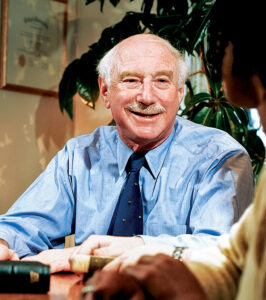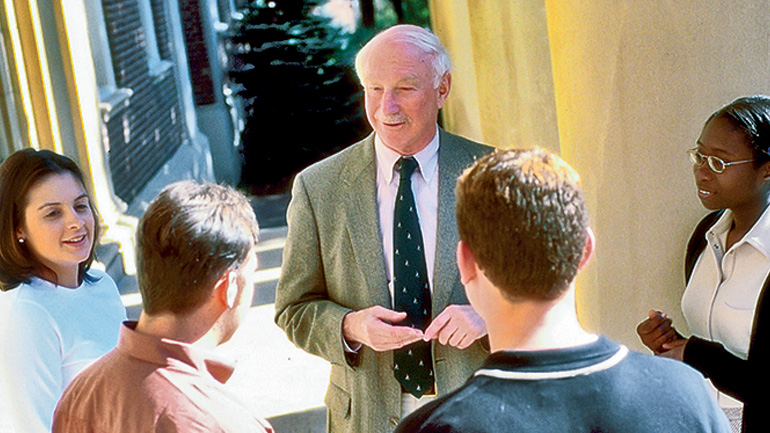Remembering Arthur Rothkopf ’55 H’05
All presidents of Lafayette receive a wooden gavel. It is not simply ceremonious. You see, at Lafayette, it isn’t the provost or the dean of the faculty who leads faculty meetings—it is the president. This can be a challenging task for some presidents early in their time. Lafayette faculty have developed their own distinctive interpretation of the Robert’s Rules of Order playbook. Despite these idiosyncrasies, I remember President Arthur Rothkopf ‘55 H’05 chairing Lafayette faculty meetings with ease. He used to reflect, with a smile, that it was because the task was akin to his experience leading large assemblies of lawyers. I never knew whether to take this Harvard-trained attorney’s comment as a compliment to the faculty or a subtle dig (insert your favorite lawyer joke here). And Arthur never let on as to which interpretation he intended.

Arthur Rothkopf ‘55 H’05
At the first faculty meeting of the year, beyond warm welcomes for new faculty and administrators, the main order of business is the president’s address on the state of the College. Arthur’s addresses were legendary. Beautifully written—a testament to him being an English major at Lafayette and the benefit of Prof. William Watt’s tutelage—these remarks were substantive treatises about the College, our current state of affairs, and the challenges and opportunities that lay ahead. Arthur devoted much time to crafting his remarks, an acknowledgment of the respect in which he held faculty and administrators. These speeches were full of insights about the higher education landscape as well as Supreme Court decisions, global economic factors, and politics, from local to national. They were a primer in informed, strategic leadership, and they were quintessential Arthur, clear-eyed and perceptive.
There was one faculty meeting I remember vividly in which Arthur rarely held the gavel, having turned the chair’s position over to the provost so he could speak substantively to a motion. Candidly, it was a contentious meeting that afternoon in Colton Chapel—debate was vigorous and emotions among the faculty ran high. Arthur’s position was at odds with some strong-willed and vocal faculty. At the meeting’s conclusion, I saw a simple act that spoke volumes about Arthur’s leadership. It would have been easy to flee the chapel, exiting quickly through one of the nearby side doors. But not Arthur. He walked down the broad center aisle to converse with one of his “opponents” and gently placed a hand on the person’s shoulder. Without overtly asking, his gesture was clear—he was checking to see that their relationship was OK. Yes, they disagreed, but it was a tussle of ideas and different viewpoints, not a battle between individuals. Arthur appreciated and valued that they had shared goals—doing what was best for the College. And although the particular tack each wanted to pursue was different, the commitment and dedication to a place they both cared deeply about was what was important. This servant leader embodied decency and honor, and he brought people together, even when they disagreed.
Life is composed of a series of small acts, seemingly unimportant but when taken together personify who we are, our ideals and values. Each and every day, every encounter with Arthur, you were struck by his warmth, caring nature, and probity. Arthur had a penetrating intellect combined with a gift for listening. He was someone who had the courage of his convictions, and I’m convinced that if you look up the definition of the word “integrity,” it says “see Arthur Rothkopf.”
Arthur also was gifted with wit and self-deprecating humor. For example, “The Accidental President” was a moniker Arthur often used to refer to himself, a play on the title of a movie popular at the time, The Accidental Tourist. It is true that the Lafayette presidency was not a position Arthur had initially sought, but he readily confessed it was the job he loved most. And the College was decidedly better because of this accident.
And, of course, who could forget Arthur’s comment in one of his first speeches that “he will be remembered as the man who brought Barbara Rothkopf to Lafayette”—an obvious nod to JFK’s famous remark. In part, he was right. Barbara had a great impact on the College and on the Lehigh Valley. Together, they were quite a duo, gracious, welcoming, and engaging. Their repartee was delightful to witness and their love for one another obvious. Arthur and Barbara’s dedication and devotion to Lafayette seemed boundless.
When one considers the 12 years of Arthur’s presidency it might be easy to focus on the buildings constructed that reshaped our landscape. These structures transformed the way we learn and live on our campus. But this would miss the true essence of the man. Arthur was about people. He had a deep and abiding commitment to all who made up the Lafayette community. It wasn’t unusual for faculty and staff to receive handwritten notes from Arthur praising an achievement, phone calls offering condolences upon learning of a family member’s passing, or a hail when walking across the Quad to join an impromptu conversation. Arthur invested in people. He readily mentored students, faculty, and staff, and was enormously generous with his time. Many career trajectories were expanded thanks to Arthur’s counsel.
Although, like all presidents, he had to travel near and far as part of his position, it still felt like Arthur was ever present, and his towering presence, both literally and figuratively, made him easy to spot—his predilection for tan tweed jackets also helped. It was obvious to all that Arthur loved being on campus, a place where in many ways he grew up, having first arrived on College Hill at age 16. He went to lectures, student gatherings, athletic events, concerts, and receptions. Arthur periodically ate lunch in the faculty-staff dining room in Marquis Hall, welcomed to a general table by those already seated and in turn, welcoming others to sit and converse about the latest issues on campus and in the world. Odds-on there was also lively talk about baseball. Sometimes in the midafternoon you might find Arthur seated alone in a booth at Gilbert’s, a quiet and peaceful place after the din of lunch, having a cup of coffee and reading The Wall Street Journal. This was likely the single brief interlude he had to himself the entire day, and yet Arthur would readily invite you to join him and then pepper you with questions about your work and interests. He was always inquisitive and always listening. Arthur could help you see things more clearly, and I hope that I, at times, did the same for him.
Fast forward to 2016. Arthur has returned to give a presentation at an event on campus. As I looked around the venue I saw many faculty in attendance, including those who might reasonably be referred to as “antagonists” during some interval of his presidency, all eager to interact with the former president. The deep affection and respect for this principled and decent man was palpable. I watched as Arthur engaged with all assembled, his warmth, wisdom, humor, and love of this community, as always, in evidence. No gavel required.
Wendy Hill, Rappolt Professor Emeritus and former provost and dean of the faculty, returned to campus to teach neuroscience in 2020. She was appointed director of the Hanson Center for Inclusive STEM Education in 2022.